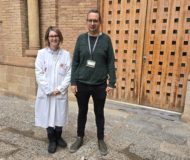

Researchers from the Sant Pau Research Institute (IR Sant Pau) have collaborated with an international team to develop a tool that promises to transform how small vessel disease associated with the NOTCH3 gene is assessed and managed, including CADASIL, the most severe presentation of this condition. Published in the prestigious journal JAMA Neurology, the study introduces a staging scale that classifies the progression of this disease into five main stages and nine subgroups, offering for the first time a clear model to understand its evolution.
Dr Israel Fernández-Cadenas, head of the Pharmacogenomics and Neurovascular Genetics Group at IR Sant Pau and one of the researchers involved in developing this classification, explains that this advancement represents a fundamental shift in the management of these diseases. “Until now, it was known that CADASIL progressed over time, but physicians lacked tools to classify its progression systematically. The new scale, however, provides a framework that allows doctors to place patients in a specific stage, which not only helps provide them with a clearer understanding of their prognosis but also reduces the uncertainty that characterises many rare diseases like this one.”
The scale has been designed to integrate data from magnetic resonance imaging (MRI) and functional assessments, tools already part of routine medical practice. According to Dr Elena Muiño, a researcher in Dr Fernández-Cadenas’ group and another contributor to the development of the classification, this means that its implementation will not require additional investments or complex technologies, a key factor for its adoption in diverse medical settings, including those with limited resources.
One of the major advantages of this tool is that it not only facilitates a better understanding of the disease’s progression but also improves the way experimental treatments are designed and evaluated. “By classifying patients according to the stage of the disease, clinical trials will be able to identify more precisely which therapies are effective for each stage,” explains Dr Muiño.
The impact of this scale is not limited to CADASIL. Although this study focused on patients with genetic variants associated with the NOTCH3 gene, the model could also be applied to other forms of small vessel disease, including sporadic forms such as those caused by hypertension. Dr Muiño emphasises that “CADASIL is considered the genetic model par excellence for small vessel disease. Therefore, it seems logical to think that this classification system will be applicable to other causes of small vessel disease, facilitating their study, which also lack a specific treatment.”
The development of the scale initially involved a cohort of 195 patients with CADASIL and was later validated in a sample of over 1,700 individuals from various regions worldwide, confirming its international applicability. Additionally, a longitudinal follow-up of up to 18 years allowed researchers to observe how the disease progresses in most patients, particularly over long periods. This knowledge not only helps set clearer expectations for patients and their families but also provides a solid foundation for designing more specific therapeutic interventions.
Despite these advances, Dr Muiño acknowledges that treating CADASIL remains a challenge. “Currently, there are no specific therapies for this disease beyond general measures to manage cardiovascular risk factors. However, implementing this scale represents an essential step towards developing targeted treatments.”
The publication of this study in a high-impact journal such as JAMA Neurology underscores its scientific and clinical significance, highlighting the importance of a multidisciplinary and international approach to tackling complex diseases like this. “This is a crucial step forward in shedding light on an area that, until now, was filled with uncertainty,” concludes Dr Muiño. “Not only are we giving patients a better understanding of what they face, but we are also laying the groundwork for future treatments that could change their lives.”
About CADASIL and the NOTCH3 Gene
CADASIL (Cerebral Autosomal Dominant Arteriopathy with Subcortical Infarcts and Leukoencephalopathy) is a genetic condition that affects the brain’s small blood vessels, causing an alteration in blood flow distribution to various brain regions. This condition is caused by genetic variants in the NOTCH3 gene, located on chromosome 19, whose alteration leads to the aggregation of the Notch3 protein and other proteins, ultimately resulting in damage to the blood vessel wall.
The progressive damage to these small vessels leads to clinical manifestations including recurrent strokes, migraines, mood disorders, and, in advanced stages, vascular dementia. Most cases typically manifest between the ages of 45 and 60, although earlier and later forms have been described depending on the location of the genetic variant and individual factors such as sex and cardiovascular risk factors.
Although CADASIL has historically been considered a rare disease, recent studies suggest its prevalence could be much higher than previously estimated. It is believed that up to 1 in 300 people carries a pathogenic genetic variant in the NOTCH3 gene. Indeed, many individuals may not develop severe symptoms or may present with milder forms of the disease depending on the location of the genetic variant. This observation has generated growing interest in research, as it could explain a significant proportion of undiagnosed cerebrovascular diseases, particularly in older adults.
Gravesteijn G, Rutten JW, Cerfontaine MN, Hack RJ, Liao Y-C, Jolly AA, et al. Disease severity staging system for NOTCH3-associated small vessel disease, including CADASIL. JAMA Neurol [Internet]. 2024; Disponible en: http://dx.doi.org/10.1001/jamaneurol.2024.4487